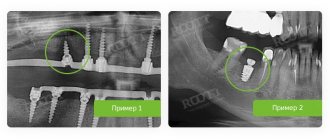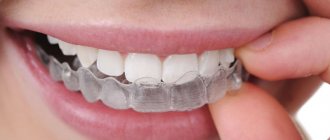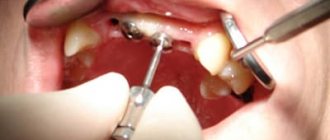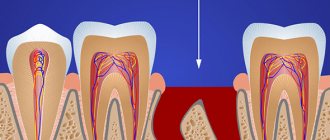Modern technologies, techniques and materials have made the dental implantation process one of the safest and most effective. But do not forget that this is a serious surgical intervention with its own characteristics. Therefore, situations where a patient’s dental implant falls out, although rare (a little more than 1% of all implantation operations), still occur in dental practice.
What to do if part of the rod comes out of the gums
When the implant is exposed, a flap operation is performed to build up its soft tissue:
- A flap is peeled off from the palate and applied to the exposed area.
- If necessary, correction is carried out on the bone tissue.
- The edges of the wound are sutured with non-absorbable thread.
- After 10 days, the sutures are removed.
- After the artificial root has engrafted, a former is placed.
Another way to correct a defect with a lack of periodontal tissue can be the transition from a two-stage installation to a one-stage method. However, it is necessary to take into account that the one-stage technique has the main drawback - non-ideal conditions during the period of implant engraftment, high risks of developing inflammation.
What causes gum recession?
Doctors include the following as the main causes of gum recession after dental implantation:
- incorrectly selected implant,
- incomplete coverage of the prosthesis with soft tissue,
- overpressure of the structure,
- eating rough food during the rehabilitation period,
- using a brush with stiff bristles,
- insufficient oral hygiene,
- progressive gingivitis or periodontitis.
To determine the exact cause of the problem, it is necessary to undergo a dental diagnosis. This should be done when the first alarming symptoms appear.
Is implant failure a sign of rejection?
If the problem of exposing the rod is accompanied by additional symptoms, it is necessary to understand their causes. Pain at the site of installation of the structure, swelling, and redness of the gums during the first week after surgery is a normal reaction to surgery, since tissue injury occurs. Signs of rejection are the following situations:
- 1-2 weeks after implantation, acute pain does not go away;
- swelling and redness of the gums do not subside after 4 days after surgery;
- discharge of ichor, bleeding lasting more than 7 days;
- the mobility of the implant is felt;
- unpleasant smell from under the plug screw;
- painful sensations when pressing on the rod;
- the appearance of purulent discharge from the gums;
- increase in body temperature.
Possible reasons
Any implant is a foreign body for the body. In order for it to take root well, it is necessary to follow the doctor’s recommendations after the operation. If you ignore the dentist's instructions, inflammation may occur, causing the structure to become unstable.
The main reasons for implant failure also include:
- installation of an unsuitable design - a product with a small diameter or length, made of metal alloys to which there is an allergy;
- mistakes made by the doctor during the operation - overheating of the bone tissue, violation of asepsis, tightening the rod too much;
- malocclusion - crowding of teeth, midline displacement, retrusion and protrusion, transposition, rotation;
- mechanical damage - bruises and fractures, causing displacement of the implant;
- chronic diseases - diabetes, immunodeficiency, blood clotting disorders.
Before installing an implant, the doctor must collect an anamnesis, conduct a comprehensive diagnosis and select a suitable design taking into account the clinical picture.
Why the design may not take root
This can happen for several reasons, related both to the course of the operation itself and to the actions of the patient in the postoperative period.
Medical error
Due to his incompetence or carelessness, an implantologist may make the following mistakes:
- choose the wrong model - the titanium root may be significantly longer or thicker than the jawbone;
- violate sterility conditions;
- incorrect installation of the implant;
- when drilling a hole for the rod, overheat the tissue;
- do not fully study information about the patient’s health status and possible contraindications.
Poor quality implant
Large dental clinics, through dealer networks, work with systems that are directly supplied from manufacturers. This eliminates the possibility of receiving a fake. In dentistry that work through intermediaries, it is risky to agree to an operation, as there is a risk of installing low-quality analogues. Therefore, you need to take the choice of a clinic and a doctor seriously, be interested in warranty conditions, survival statistics, and other important points.
Failure to comply with operating and maintenance rules
Even if the doctor performs the operation correctly, observing all the norms, problems with implant healing may arise due to the patient’s fault. Among its possible errors:
- providing the doctor with incomplete information about your well-being and health status. Even minor facts must be stated;
- excessive load on the implant during the healing period;
- failure to follow the rules of oral hygiene - even artificial teeth require careful care;
- hypothermia or overheating in the first days after surgery (visiting a sauna, diving into ice water);
- undisciplined use of medications prescribed by a doctor.
Deterioration of health
Rejection may occur several years after implantation. In addition to mechanical damage, the cause may be the development or exacerbation of:
- cardiovascular diseases;
- diabetes;
- AIDS;
- tuberculosis;
- oncological diseases.
The risk of rejection increases significantly if the patient smokes . Nicotine and tar disrupt the nutrition of mucosal cells, which has a negative effect on the condition of the tissues around the installed rod.
Implant exposure
For normal healing and functioning of a dental implant, it is necessary not only to fully integrate it with the bone, but also to fit tightly around the gums. Soft tissues do not “grow” into the implant, but protect the bone and the titanium rod itself from infection. If the mucous membrane is not able to protect the implant, then exposure of its neck may occur. In addition to the unaesthetic appearance, this creates favorable conditions for the development of inflammation due to the accumulation of bacteria and plaque. Subsequently, this can provoke re-implantitis, lead to loss of implant stability and even to its rejection.
Implant exposure is a fairly common phenomenon observed after classical (two-stage) dental implantation. It manifests itself as exposure of the metal rim of the abutment under the crown and the formation of a black stripe. The implant does not become exposed immediately, but over time, and causes patients a feeling of psychological discomfort due to the deterioration of the appearance of the teeth. This often happens when installing implants with a polished neck that remains above the bone. Using an implant with a surface completely covered with threads allows it to be inserted deeper. Exposure of the cervix also occurs when the thickness of the mucous membrane is less than 2 mm. This is most often observed during prosthetics of the front teeth, where the mucosa is very thin.
For information about prices and treatment times, call:
+7
or fill out the feedback form:
Reasons for implant exposure
- Incomplete coverage of the dental implant by gum tissue due to improper flap formation and tension
- Excessive pressure from a temporary crown
- Injury to the gums by rough food in the first days after surgery
- Failure of the patient to comply with other implant care recommendations
- Bone subsidence after many years of using implants.
How to eliminate implant exposure?
Exposure of the implant is not considered a serious complication, but if it causes discomfort to patients, immediate correction will be required. The situation can be corrected in two main ways: by performing implantation using a one-stage method and soft tissue plastic surgery.
- Switching to a one-stage protocol involves replacing the plug with an abutment, which supports the crown. In this case, it is more difficult to insure against infection and guarantee the stability of the implant, because a two-stage scheme was initially chosen.
- Gum extension and elimination of soft tissue defects allows you to adhere to the same implantation technology (two-stage) and at the same time avoid infection. Despite the fact that this requires additional surgical intervention, the main way to solve this problem is gum augmentation.
How can I avoid exposure of the implant?
First of all, patients must follow all recommendations in the postoperative period to avoid pressure on soft tissues. In addition, if you do not limit smoking and alcohol consumption, then over time the intraosseous parts of the implant will become exposed.
During the implantation process, exposure of the cervix can be prevented by professionally performed installation in compliance with all the subtleties of the technology. Certain guarantees can also be given when using high-quality implants with an individual abutment, since this creates a tight gum ring and prevents exposure of the neck. When implantation is performed in our clinic, the process of such complications is minimal. We employ qualified doctors who use German implants, the design of which allows us to avoid such consequences. To reduce the risk of implant exposure in the future, we can also offer custom abutment manufacturing.
How is inflammation treated?
If signs of inflammation appear, you should immediately consult a doctor . He will conduct an examination and order an x-ray. If necessary, temporarily unscrew the implant plug and clean its outer surface.
Signs of advanced peri-implantitis are eliminated by removing the structure, since an advanced inflammatory process will lead to the spread of infection. At the initial stage, surgical sanitation of the focus of gingival inflammation is carried out:
- They make an incision.
- Granulation tissue is removed.
- The surface of the titanium root is cleaned with a Prohy-Jet apparatus or special curettes.
- Rinse the pocket.
- After the operation is completed, the patient is prescribed antibiotics and antiseptic rinses.
The conservative phase of treatment includes procedures:
- Professional oral hygiene.
- Irrigation with ozonated solution.
- Laser therapy.
- Oral applications and baths are prescribed.
Possible causes of dental implant loss
“Implanting” a titanium rod into the jawbone is a surgical operation that is carried out in strict accordance with the established protocol. At each stage, you must comply with all conditions and follow recommendations. Both specialist errors and violation of prescriptions on the part of the patient can lead to the implant not taking root. There are other provoking factors.
The most common reasons for implant rejection, as a result of which it will have to be removed:
- Poor quality workmanship. Survival rates are highest for implantation systems manufactured by reliable manufacturers.
- Violation of the dentist's recommendations by the patient. In particular, neglect of scheduled visits to the doctor, failure to maintain oral hygiene after installation, and heavy loads on the implant.
- Injuries. If there is a blow to the jaw area, the implant may be damaged or displaced, and lose stability of fixation.
- Smoking. Tobacco smoke has an extremely negative effect on blood vessels, leading to their spasms, which disrupts tissue nutrition and oxygen supply. As a result, the implant may be rejected.
Less common reasons for implant loss include patient hypersensitivity to manufacturing materials, violation of prosthesis manufacturing technology, and uncontrolled use of medications.
How much does it cost on average in Moscow?
Treatment of complications
| Name of service | Cost, rub. |
| Periodontal applications in the area of 1 tooth | 370 |
| Application of a protective periodontal bandage | 400 |
| Laser therapy of the gum mucosa | 490 |
| Implant removal | 6900 |
| Implantation of osteoconductive material in the area of 1 tooth | 10900 |
| Implantation of a protective membrane (1 tooth) | 12900 |
Gum plastic surgery
| Name of service | Cost, rub. |
| Plastic surgery of marginal gums | 1200 |
| Gingivoplasty (1 tooth) | 1500 |
| Plastic surgery of marginal gums (segment) | 3500 |
| Plasty of gingival margin recession | 3500 |
| Flap surgery in the area of one tooth | 3500 |
| Smile line plastic surgery | 4000 |
| Gingivoplasty (1 tooth) using laser | 4000 |
| Gingivoplasty (segment) | 4500 |
| Flap surgery (three teeth) | 7000 |
| Gingivoplasty (segment) using laser | 10000 |
| Flap surgery (segment) | 10000 |
| Flap surgery (whole mouth) | 30000 |









